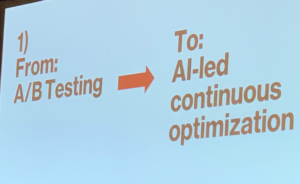We recently attended the 2019 Open Mobile & Digital Experience Summit to learn where industry thought leaders believe digital experiences are headed. To our delight, everything we heard reaffirmed Evolv’s commitment to the idea of building a culture around experimentation and optimization.
Implementing an effective optimization strategy requires more than a few A/B tests. Digital experiences are complex, and successful companies are now prioritizing the full funnel experience.
We’ve compiled some key takeaways from the 2019 Open Mobile & Digital Experience Summit to help you understand what the industry looks like, where it’s headed, and how you can be a part of the next wave of digital transformation and customer experience-driven innovation.
1. Change Still a Major Obstacle for Large Companies
Larger companies are finding it challenging to modernize their customer experiences. This process becomes even more complicated when you account for legacy infrastructure; technical, process, and culture debt; and other core aspects of the business that are less receptive to change.
The more legacy infrastructure you have in place, the more processes and mindsets you need to change. During the conference, Macy’s Inc.’s Chief Digital Officer, Jill Ramsey, spoke about how mature companies like hers are working hard to reorient themselves around tech-savvy customers — and with Macy’s mobile app serving as the company’s fastest-growing channel, it’s evident these sorts of efforts can have a big payoff.
2. Go Big or Go Home
Impactful changes require a wholesale commitment to creating memorable digital experiences from top to bottom.
You can’t pick and choose specific areas to improve. Taking a quantum leap and creating a solid customer experience requires that you update everything about your business, from your strategies, processes, people, organization and culture, to the technology you use.
3. Industry Shifting From A/B Testing to AI-led Continuous Optimization

Traditional A/B testing is too slow. One company that presented at the conference mentioned that nearly 80% of its increase in online sales over the last 12 months came from AI-led continuous optimization.
Your optimization strategy needs to be an ongoing process. Successful companies are always experimenting new ideas, validating existing strategies, and searching for innovative ways to improve the customer experience. Your customers and competitors are never at a standstill, so resting on your laurels isn’t an option.
Identity Praxis’ Michael J. Becker mentioned that you need to develop auto segmentation and targeting to effectively create customer experiences that people find relevant and impactful, because there is too much data involved to do all this manually.
4. Shift From Centralized CX to CX Everywhere
For years, companies have used isolated teams to fix specific elements of the customer experience. This strategy, according to Donald Chestnut, Chief Experience Officer at Mastercard, is ineffective today.
Today, companies must get everyone involved in thinking about the customer experience and design thinking. This means doubling down on research and exploration, understanding what your customers actually want, and delivering experiences that meet their needs.
Everyone thinks personalization is the answer, but customers don’t care about personalization — they want relevance.
5. Maximizing for Moments of Truth
Everything you do is part of the customer experience in some way, whether it’s a simple customer-facing landing page or intuitive functionality that you build into your website or app.
Key customer interactions need to be owned and optimized with a focus on why those interactions are important in the first place. A utility company may improve their customer experiences by implementing online bill pay and reporting and reviewing power outages. In contrast, an ecommerce company may streamline the checkout process with an easy add-to-cart and checkout workflow and enhance the post-sale process by improving shipping visibility with a tracker and providing enhanced customer support.
A successful digital transformation needs to identify what these moments of truth are and how they can be improved through full-funnel optimization.
6. Experiment a Lot, and Experiment Everywhere
Experimentation shouldn’t be an isolated instance. According to Moovit’s Chief Growth & Marketing Officer, Yovav Meydad, exploring options for improving the customer experience everywhere within the organization matters.
Your optimization strategy may start at the top of the funnel, but it should take place extensively throughout the user journey, as well. For companies with distributed business, this may mean prioritizing localized testing to meet the unique needs of different target markets.
Creating and implementing a culture of optimization requires that your company establish benchmark KPIs to compare experimental results against. This approach will provide you with rich insights about how you’re improving outcomes, supporting your push for continuous optimization.
Remember, an effective strategy is about continuous optimization, not one-and-done campaigns.
7. Moving From Offline to Online
Tech companies are natively digital. However, legacy industries like retail, banking, and telecom don’t have this advantage. Their digital transformations can be long and complicated. There are several unique challenges that these industries face, including:
- Bridging the gap between legacy and digital operations
- Overcoming established engagement with print vs. digital communications
- Creating effective customer experiences that are primed for digital engagement across multiple channels — in-store and online, on mobile and on desktop, and in social media and in real life (IRL).
Digital experiences are created to replace legacy solutions, but are they more effective than the original solution they are replacing? Designing a new customer experience for the digital age is important, but not at the expense of creating an inferior outcome for your customers.
Product and consumer success teams built around the ideas of speed and innovation are an effective way to tackle the challenge of moving from offline to online engagement.
8. AI Is Not a Magic Bullet
Solutions built on artificial intelligence can do a lot for your company, but AI isn’t a magic bullet. According to Tim Salau, WeWork’s Global Product Marketing Manager, 65% of executives report that they do not see any revenue gains from their AI investments and strategies.
Don’t invest in AI because it sounds interesting. This innovative technology helps you solve defined business needs — but you need to define those needs first. Take the time to assess where your customer experiences are falling short, what pain points your customers have, and how you can solve those problem areas.
AI can expedite your digital transformation, but only if you know what to transform in the first place.
How Is Your Company Implementing a Culture of Optimization?
It’s clear that customer experiences are the defining feature of the push for digital. Companies in all industries are starting to embrace the idea that winning customer experiences require a full-funnel optimization strategy.
Evolv is an industry-leading continuous optimization platform that companies can use to improve customer experiences across all areas of their funnels. Whether you’re looking to improve the web, mobile, or in-app experience, Evolv can streamline your experimentation processes and provide you with meaningful insights to guide your marketing strategies.
Are you interested in seeing how Evolv can help you create better customer experiences from top to bottom? Get in touch with a member of our team today to learn more.
— Michael Scharff, CEO


.jpg) Michael Scharff
Michael Scharff



